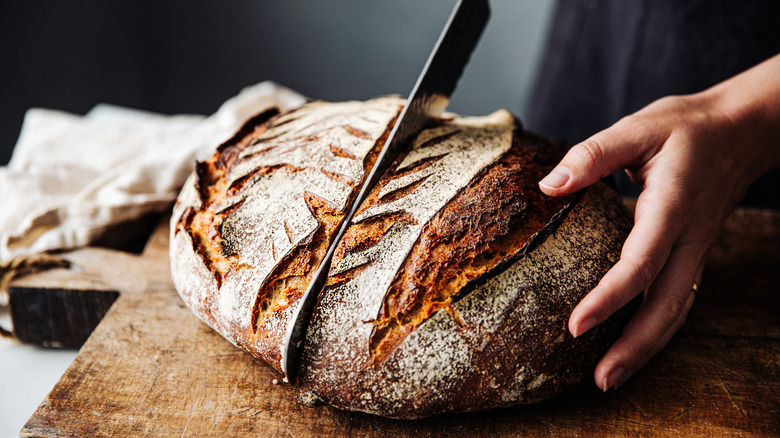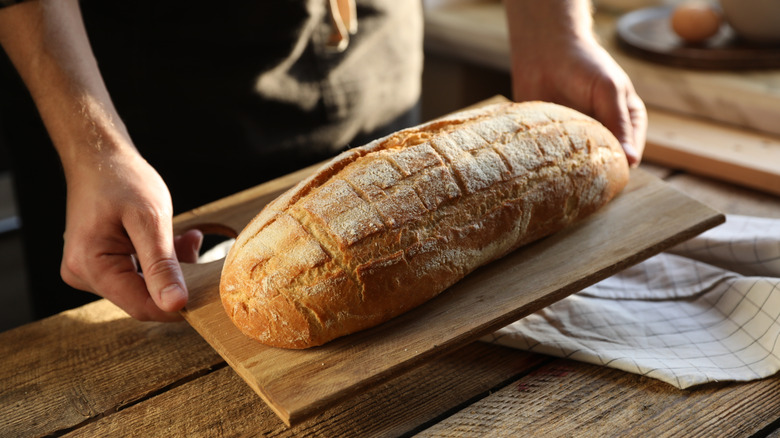Yes, You Can Save Your Undercooked Bread. But You Have To Act Fast
The aroma of freshly baked bread wafts across the kitchen. You have patiently waited for your bread to cool in anticipation of that scrumptious first bite of warm, rustic bread. You slice through the perfectly golden, crusty exterior of your loaf of bread, giddy with excitement, only to be dejected by a dense, gummy, undercooked center. But, before you toss that loaf into the trash along with your hopes and dreams for delicious homemade bread, you'll be pleased to know that your undercooked bread can be salvaged!
All you need to do is heat your oven to 350 degrees Fahrenheit and return the undercooked loaf for an additional 10 to 20 minutes of baking. This technique works even if your bread has already cooled. If your undercooked bread has the coveted, golden crust and you're worried about it over-browning during the second bake, simply tent the loaf with aluminum foil, and you're set. Another key factor to consider is how far the bread has progressed in its completion. If you've caught the problem when the bread is nearly finished cooking, the extra few minutes in the oven ought to do the trick. However, if the bread is severely undercooked with a completely raw center, attempting to revive it might be a lost cause.
Don't have time for an immediate rebake? Treat your undercooked loaf as par-baked bread. Once completely cooled, wrap tightly or store in a freezer-safe airtight container, and freeze it as you would for long-term storage of fully-baked bread. When you're ready to enjoy it, thaw it overnight in the refrigerator, finish baking for a few minutes longer than your recipe suggests, and enjoy.
Avoid undercooked bread with these simple tips
Now that your precious loaf of bread has been rescued by a few extra minutes in a heated oven, resulting in a perfectly airy, soft interior, let's delve into simple tips to avoid the entire ordeal of salvaging incompletely baked bread. There are multiple mishaps that can ruin your bread, several of which are responsible for improperly baked bread. With a handful of tips and tricks in your arsenal, you can ensure your loaf is baked to perfection from crust to crumb.
Something as fundamental as ensuring proper oven temperature can make a significant difference, as some home ovens can be inaccurate by several degrees, which can impact the final result. In addition, the preheating process is pivotal in your baking game. Your oven needs sufficient time (at least 20 minutes) to reach a stable temperature and develop the proper radiant heat that bread requires before placing the dough in to bake. An oven thermometer can be beneficial to have on hand to ensure accurate oven temperatures, while proper placement in the oven — ideally the middle rack — ensures even cooking. Make sure to weigh out your ingredients correctly with a high-precision kitchen scale for a precise flour-to-moisture ratio, which also determines proper doneness.
Having an instant-read thermometer comes in handy to avoid any future catastrophic baking episodes. For soft breads, an internal temperature of 180 to 190 degrees Fahrenheit is ideal, while 200 to 210 degrees Fahrenheit is optimal for crusty varieties. If you don't have a thermometer, just tap the bottom of the loaf once fully cooled and listen for a hollow sound indicating it's ready. Finally, remember that proper cooling is critical. What seems undercooked might simply need time for the internal steam to escape, so allow your bread to cool completely (at least two hours) on a rack before slicing. With these easy techniques, you'll bid farewell to disappointing, undercooked bread, and forever be in your expert bread-baker era.

